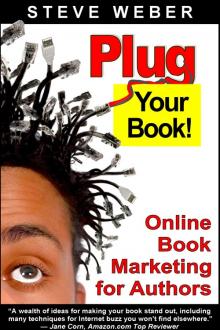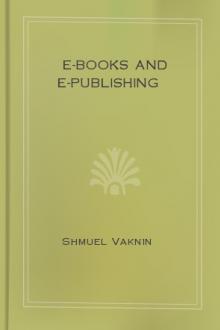Plug Your Book! by Steve Weber (books to read to be successful .txt) 📕

- Author: Steve Weber
- Performer: -
Book online «Plug Your Book! by Steve Weber (books to read to be successful .txt) 📕». Author Steve Weber
BookSurge is an Amazon subsidiary that provides print-on-demand (POD) service. POD is used by a variety of publishers who prefer to print certain titles in small batches, rather than ordering a large quantity of traditionally printed books, requiring immediate capital, shipping and storage.
BookSurge is marketed as a service for self-publishing authors, but is just one of several options. For a full discussion of the merits of POD versus offset printing--and self-publishing versus trade publishing--read _ Print-on-Demand Book Publishing_ by Morris Rosenthal.
Your Amazon profile#Few know it, but each Amazon customer has a Profile page. If you have an Amazon account, you can see your profile at:
#www.Amazon.com/gp/pdp#
Your Amazon profile is a convenient place to access and manage content you've posted to Amazon, like book reviews, Listmanias, blog posts, and So You'd Like to... guides.
For book authors, an Amazon profile provides yet more opportunities to educate shoppers about your titles, and to refer them to your own Web site if you wish. You can upload your photograph, post a short biography, and add several personal details.
If you have an Amazon Connect blog, your posts are displayed on your Amazon profile, along with some anonymous feedback from readers, such as "5 of 6 readers who voted liked this post."
On the right column of your profile, you can set preferences for display of your Amazon Wishlists and previous purchases. By default, your previous Amazon purchases are publicly viewable, but you can make them private.
Amazon friends#Like profiles, "Amazon friends" is a little-known feature, but is gaining prominence as the company emphasizes community features. Designating someone your Amazon friend provides an easy way for you to track his or her community participation on Amazon. Depending on the privacy settings on both profiles, you can view each other's recent purchases, Wish Lists, upcoming birthdays, and e-mail address.
Adding someone as an Amazon friend can help you find people interested in networking or receiving a review copy of your book. To make an Amazon friend invitation, scroll about two-thirds of the way down your profile page, #www.Amazon.com/gp/pdp#.
You'll see a heading for #Amazon Friends & Interesting People# and a search box where you can input names or e-mail addresses. Clicking on the person's name or e-mail address allows you to send a message that will be forwarded by Amazon.
Amazon users have three options in responding to a friend invitation:
Accept # -- Both members become each other's Amazon friend and appear on each other's list of Friends. Decline# -- The sender's invitation is removed from a list of pending invitations on the invitee's profile. The sender isn't notified the invitation is declined, and is free to send future invitations. Decline and block# -- Declines the invitation and prevents future Friends invitations. The sender's name appears in a "Blocked People" list visible to you on your profile, and you have the option of unblocking them later. Ignore# -- The default option, and probably the most popular. The recipient ignores the Friends invitation and deletes the e-mail.Amazon users have the option of receiving friend invitations only from people who know their e-mail address and enter it correctly into the invitation form. Here's how to manage this setting:
On your profile page, scroll down the middle column to the section labeled #Amazon Friends & Interesting People#.
Click See your pending invitations.
At the bottom, in the section labeled #Blocking Preference#, check the box #Block invitations from people who don't know my e-mail address# and click the yellow button #Save preferences#.
Interesting people#Amazon's Interesting People feature lets you bookmark authors or reviewers you're interested in, and enables you to see their latest Amazon activity on your Profile page--new book reviews, tagging activity, etc. To add someone to your interesting people list, go to their profile page and, in the box labeled #Your Actions#, click the link Add to Interesting People. You can search for people to add to your list by selecting #People# from the search pull-down menu at the top left corner of your profile page.
Because so many sales can result from Amazon recommendations, it's worth spending a few minutes looking under the hood. Here's a shortcut to your Amazon recommendations:
www.Amazon.com/yourstoreOn the left, click Books to filter out other types of products. Now, directly below each of the recommended books, you'll see the reason it's being recommended, such as: #Recommended because you purchased [TITLE].#
For each book recommended, you can refine the system by indicating:
Whether you own the book.
Whether you're just "not interested" in the recommended book.
Your rating for the book on a scale of 1 to 5, with 5 meaning "I love it."
Few Amazon customers take the time to confirm this raw data in Amazon's recommendations engine, and as a result it can spit out some wacky suggestions. If you've purchased books for children or friends that you wouldn't read yourself, the result is faulty recommendations.
In some cases, Amazon will guess correctly which of your purchases are gifts--for example, when you ship a book to a different address--and excludes them from recommendations.
Here's how to exclude other inappropriate books from your recommendations:
Near the top of your recommendations list is the text, "These recommendations are based on items you own and more."
Clicking you own shows the list of books Amazon knows you've purchased.
To exclude books from the recommendations system, uncheck the box labeled #Use to make recommendations#.
You can also improve your recommendations by letting Amazon know about books you've purchased elsewhere.
The star ratings you assign to books on this list won't be visible to other Amazon users, but the ratings can affect which books get recommended to whom and how often.
As you scroll through the list of books, be on the lookout for quality books you've read that are complementary to your book. When you find one, check the box #Use to make recommendations# and assign it a 5-star rating. This will encourage Amazon to recommend your book to other users with your same buying and rating history. This will help seed Amazon's recommendation system for your book.
Here's a way to further jump-start your book in Amazon's recommendation system: Buy other books published in your niche, along with your own book. Ask your friends and family to buy them also. This will inject your title into the recommendation engine. It won't dictate the long-term position of your book; that will depend on the independent actions of many thousands of customers. But those paired purchases, if relevant, can surface your title in Amazon recommendations weeks earlier than might otherwise occur.
Pricing and discounting strategiesMuch of your exposure on Amazon depends on how many sales you rack up. The more sales, the more often Amazon gives your book free exposure in its Also-Bought lists, Better-Together spots, and recommendations on its Web site and in e-mails. It's a virtuous cycle, one that can make a successful book even more successful.
For most of Amazon's history, this system has been neutral--your exposure was determined purely by sales. The playing field was level. It didn't matter whether a book was by a famous author or an unknown, or published in New York or in your neighbor's basement. It didn't matter whether the book was a pocket-sized paperback or a leather-bound collector's edition. Amazon's customers voted by buying, and books with the best sales got the most exposure.
In mid-2006, however, Amazon changed this system, perhaps with an eye toward improving its quarterly financial statements. Amazon boosted exposure of expensive books and those with big wholesale discounts. Meanwhile, it cut exposure for books with lower prices and so-called "short" discounts. In other words, Amazon began showing customers not necessarily the _best _recommendation--the book most popular among similar buyers--but recommendations filtered according to how profitable the books are for Amazon to sell.
It's unclear exactly what formula Amazon is using to filter its recommendations. Some publishers believe a book's list price is the more important factor, while others believe the wholesale discount matters more. Whatever the formula is, apparently it's a secret. In fact, at least one Amazon executive has flatly denied the company is filtering recommendations at all, although the effects of the practice have become clear to many publishers who track their Amazon sales closely. Many of those publishers are irritated that Amazon seems to be favoring publishers who give bigger wholesale discounts than the 40 percent they have traditionally given to brick-and-mortar bookstores.
It's also unclear whether Amazon's practice of recommendation filtering is a wise long-term strategy. Some customers may begin ignoring recommendations and buy fewer books if they realize that certain books are being recommended mainly because they're expensive. After all, buyers who pay close attention to Amazon's book recommendations tend to be the company's most profitable customers.
In any case, it seems that publishers who want to boost exposure of their titles on Amazon should consider raising their list price and offering generous wholesale discounts of perhaps 55 percent, instead of short discounts, such as 25 percent.
Social searchIn the mid 1990s, Yahoo, the first popular Web portal, guided most Internet traffic with a simple hand-picked menu of sites. Yahoo's editors decided which Web sites were worth pointing to, and that's where the traffic went. At the time, it seemed like a good system, and much more efficient than search engines, which tended to spit out mountains of irrelevant results. Back then, it sometimes seemed easier to find a needle in a haystack than to find anything with a search engine.
Then Google built a better mousetrap. Instead of relying on humans to figure out which content is best, Google's computers determined relevance and authority. Google's PageRank system considers not only the words contained on a Web page, but also how many related sites link in. Each incoming link is a vote on a page's importance, helping it rise to the top of Google's search results.
As good as Google's system is, however, it can't always deliver relevant results, particularly for specialized content. Sometimes providing good search results requires direct human brainpower, something provided by social search tools. Social search works best in deep niches, where people who truly understand the content render judgments. In these cases, social search can be more accurate than Google's algorithmic search, which counts links only.
Why should authors care about social search? Because more and more people are using it to find the exact content they want.
Here's what can happen if your book's Web site or blog is mentioned favorably on a social search service--a flood of 5,000 to 10,000 visitors can come to your site within hours. This crowd can include thousands of folks highly passionate about your topic, and those nearly impossible to reach through traditional advertising or publicity.
Dozens of popular sites have emerged in the past few years providing tools for search, social networking, and social bookmarking:
del.icio.us http://del.icio.us# was launched in 2004 and is a dominant social bookmarking site. It's a handy way for people to store their favorite Web bookmarks online where they're portable, instead of on the PC, confined to one machine.For example, a student writing a dissertation might use del.icio.us to track all their source materials and commentary. Instead of having a hard-to-read list of bookmarks in a drop-down menu on their Web browser, users just consult their del.icio.us page to view their favorite Web resources, along with their own annotations.
To organize their bookmarks, del.icio.us users tag them with personalized keywords, like a folksonomy, instead of using a hierarchical taxonomy or set categories.





Comments (0)